 Y’know, you read a lot about corporate accounting scandals, but you never think it’ll happen to someone you know. For the last year, we’ve been making jokes about Martha Stewart and Enron, and we had no idea there was some creative arithmetic going on right here at home.
Y’know, you read a lot about corporate accounting scandals, but you never think it’ll happen to someone you know. For the last year, we’ve been making jokes about Martha Stewart and Enron, and we had no idea there was some creative arithmetic going on right here at home.
I’m talking about the Muppets’ Big Brag Numbers, the ones they pull out every time they want to impress somebody: How many countries The Muppet Show aired in, and how many worldwide viewers they had. These numbers have always been a great source of pride for the Henson company; it gives them something to talk about at their high school reunions.
But I’ll bet you didn’t realize how slippery those numbers are — and how the company suddenly did some accidental book-cooking just in time for the 25th anniversary. Allow me to connect the dots for you.
 The earliest Big Brag Number that I’ve found appeared in a TV Guide article, from Aug 6, 1977: “Sesame Street, and its variations, says Jim [Henson], is seen in over 40 countries. The Muppet Show is seen in 103.” Now, you have to admit that’s impressive — 103 countries, and the show’s only been on for a year. Lew Grade must have worked the phones like a demon that year. He probably did cold-calls to everyone in the United Nations. So, there you have it: Jim says 103, it must be 103, right?
The earliest Big Brag Number that I’ve found appeared in a TV Guide article, from Aug 6, 1977: “Sesame Street, and its variations, says Jim [Henson], is seen in over 40 countries. The Muppet Show is seen in 103.” Now, you have to admit that’s impressive — 103 countries, and the show’s only been on for a year. Lew Grade must have worked the phones like a demon that year. He probably did cold-calls to everyone in the United Nations. So, there you have it: Jim says 103, it must be 103, right?
The same number was used a couple months later by Gene Shalit, writing in Ladies’ Home Journal in Oct 1977: “They’re a small-screen scream in 103 countries.” But a month later, in People Magazine (Nov 7, 1977), the math started getting a little hard to follow: “Now the Hensons are repeating their wacky success with The Muppet Show, an Emmy winner syndicated in 163 US cities and an astonishing 103 foreign countries.” Now, that throws the whole thing into question, doesn’t it? Is it 103 foreign countries — making it 104 total, counting the US? Or what?
We’re back to the 103 number a few months later, in a Muppet Show Fan Club newsletter (vol. 1, no. 2, early 1978): “The Muppet Show is now one of the most widely viewed shows in the world. In many of the 103 countries where it can be seen, the characters’ voices are dubbed into the native language.”
So at this point — midway through Season 2 — it looks to me like 103 countries is the official Henson estimate, and the dumb ol’ People Magazine writer just misunderstood what they were saying. But later in 1978, the plot thickens.
 Time Magazine covered the Muppets twice in late 1978 — a one-page article on the shooting of the Muppet Movie (Aug 28, 1978), and a six-page article after the filming was complete (Dec 25, 1978). The August article boasts: “With 156 outlets in the US and 106 overseas, it is the most popular first-run TV show internationally.” Again, that looks like 107 countries total. The August 78 article also includes the first estimate I can find on the worldwide viewership: “But to the Muppets’ 235 million worldwide fans, the real heros of all this silliness are sensitive Kermit the Frog, his friend Fozzie…” It’s never made clear where these numbers come from — how do you go about estimating the number of people watching The Muppet Show in Brunei? — so Time hedges their bets a little in December: “The Muppet series is seen by at least 235 million people in 106 countries.” So, Time Magazine, is that 106 foreign countries, or 106 countries total? I hope they didn’t lose track. They’d have to start counting all over again.
Time Magazine covered the Muppets twice in late 1978 — a one-page article on the shooting of the Muppet Movie (Aug 28, 1978), and a six-page article after the filming was complete (Dec 25, 1978). The August article boasts: “With 156 outlets in the US and 106 overseas, it is the most popular first-run TV show internationally.” Again, that looks like 107 countries total. The August 78 article also includes the first estimate I can find on the worldwide viewership: “But to the Muppets’ 235 million worldwide fans, the real heros of all this silliness are sensitive Kermit the Frog, his friend Fozzie…” It’s never made clear where these numbers come from — how do you go about estimating the number of people watching The Muppet Show in Brunei? — so Time hedges their bets a little in December: “The Muppet series is seen by at least 235 million people in 106 countries.” So, Time Magazine, is that 106 foreign countries, or 106 countries total? I hope they didn’t lose track. They’d have to start counting all over again.
Anyway, around the same time, the official Henson estimate ratcheted up a notch. In the Muppet Show’s Spike Milligan episode, shot in December 1978, Kermit boasts that the Muppets are now being seen in 108 countries — the highest estimate yet. This number is echoed in the winter ’79 Muppet Show Fan Club newsletter, where they make it into a word-find puzzle: “The Muppet Show is now shown in 108 countries, with 235 million viewers each week. Listed are 83 of these countries… see how many you can find!” Of course, the list provided only includes 80 countries, so you can see that at this point, everybody involved has lost the ability to count. (If you’re really interested, see below for the list of “83” countries.)
Now, they may be filling the fan club members’ heads with pretty lies, but everybody knows you can’t fool The New York Times Magazine, who did a big cover-story profile on June 10, 1979: “The Muppet Show, which begins its fourth season in September, is the top syndicated television program in the United States, according to a Nielsen analysis. It has some 235 million television viewers in 102 countries. Significantly, more than half of that audience is estimated to be adult (75 percent in Britain).”
 Bam! The NYT knocks the puppets down a peg, from 108 countries to 102. They still cite the same 235 million viewers figure, so I guess all the Muppet Show viewers from the extra 6 countries must all have moved next door when they heard they weren’t part of the estimate anymore. And does that “half of the audience is estimated to be adult” sentence sound a little odd to anyone? Why 75 percent in Britain? Who’s making these numbers up?
Bam! The NYT knocks the puppets down a peg, from 108 countries to 102. They still cite the same 235 million viewers figure, so I guess all the Muppet Show viewers from the extra 6 countries must all have moved next door when they heard they weren’t part of the estimate anymore. And does that “half of the audience is estimated to be adult” sentence sound a little odd to anyone? Why 75 percent in Britain? Who’s making these numbers up?
Well, whoever it is, they started messing around again a few months later, as you can see in the People Magazine cover story about Miss Piggy (Sept 3, 1979): “Miss Piggy burst into celebrity as the star of The Muppet Show, a huge TV hit that is aired in 106 countries and seen every week by 260 million viewers — among them Sophia Loren and the prime minister of Britain.” (Without those two, I guess, it would be 259,999,998. Thank goodness they started watching!)
Am I being completely boring yet? It’s hard to make this kind of material interesting, but once I started looking this stuff up, I couldn’t stop until I was done. Well, you’re still reading, so it can’t be that bad. On we go.
 Seventeen Magazine weighed in on the controversy with typical teenage enthusiasm (Nov, 1980): “Each week, The Muppet Show is seen in 106 countries by more than a quarter of a billion viewers.”
Seventeen Magazine weighed in on the controversy with typical teenage enthusiasm (Nov, 1980): “Each week, The Muppet Show is seen in 106 countries by more than a quarter of a billion viewers.”
Then, a month later, the Saturday Evening Post went even further (Dec, 1980): “At last count, more than 325 million in 106 countries are addicted to Henson’s homely heroes and heroines.” Now, that’s the biggest viewership estimate I’ve found, but it’s so much bigger than all the others that I suspect that they made a mistake, and really meant to print the more common 235 million estimate.
By the time the show went off the air, Henson had decided on a new estimate, which was included in TV Guide’s cover story interview with Miss Piggy (Aug 1, 1981): “You are known to millions and millions of people in more than a hundred countries,” coos the interviewer, and he adds, “almost a quarter of a billion people have watched you and your fellow stars of The Muppet Show each week.”
That “more than a hundred countries” phrase seems to be the official post-TMS estimate; it pops up again in all the official sources I could find, including Jim Henson: The Works (1993), the Henson celebration in Variety (Dec 11, 1995), and Jim Henson’s Designs and Doodles (2001).
 Then, in 2002, the official estimate changed. In Henson’s May ’02 press release promoting the Muppets’ appearance in Denny’s commercials, this sentence appeared in the boilerplate: “This year they are celebrating the 25th anniversary of The Muppet Show, the Emmy Award-winning television series that aired in over 120 countries.”
Then, in 2002, the official estimate changed. In Henson’s May ’02 press release promoting the Muppets’ appearance in Denny’s commercials, this sentence appeared in the boilerplate: “This year they are celebrating the 25th anniversary of The Muppet Show, the Emmy Award-winning television series that aired in over 120 countries.”
That phrase has been repeated over the last year, most recently in the June ’03 press release about the Muppet products at the Licensing Show.
So somebody over at Henson has been fudging the books, pencilling in an extra 20 countries for nefarious purposes that only they understand. Or, more likely, somebody just mixed up “more than 100 countries” with “120 episodes,” and nobody’s caught the mistake yet.
Either way, that still puts them behind Sesame Street — which, according to the Sesame Street Unpaved book in 1998, is seen in “more than 140” countries. Let the games begin!
Muppet Mania Sweeps the Globe!
List of countries from the Muppet Show Fan Club newsletter:
Abu Dhabi, Algeria, Antigua, Argentina, Australia, Austria, Bahamas, Bahrain, Bangladesh, Barbados, Belgium, Bermuda, Bolivia, Brazil, Brunei, Canada, Chile, Colombia, Costa Rica, Cyprus, Denmark, Dubai, East Germany, Ecuador, Eire, Finland, France, Gibraltar, Great Britain, Holland, Honduras, Hong Kong, Iceland, Israel, Italy, Ivory Coast, Japan, Jordan, Kenya, Kuwait, Lebanon, Luxembourg, Malaysia, Malta, Mauritius, Mexico, Monaco, Morocco, Netherlands Antilles, New Zealand, Nicaragua, Nigeria, Norway, Panama, Paraguay, Philippines, Portugal, Puerto Rico, Qatar, Rumania, Saudi Arabia, Sierra Leone, Singapore, Spain, Surinam, Swaziland, Sweden, Switzerland, Taiwan, Thailand, Tobago, Trinidad, Turkey, Tunisia, Uruguay, Venezuela, West Germany, Yugoslavia, Zambia, United States. [The US was printed last in the list.]
By the way, there are currently 193 independent countries in the world, if you count Taiwan, which the Muppets apparently do.
by Danny Horn




